
Clemens Tremmel endless, nameless
Berlin 27 Apr – 17 Jun 2023
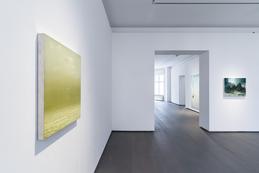
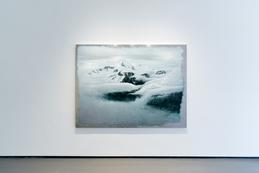
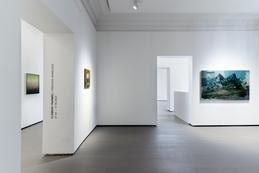
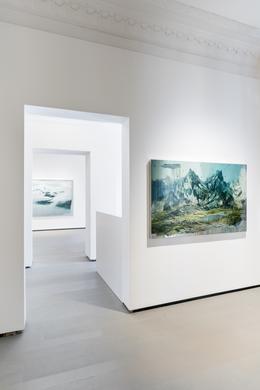
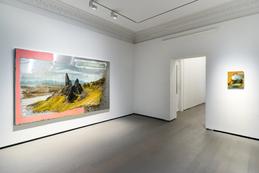
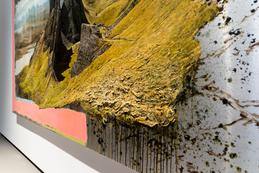
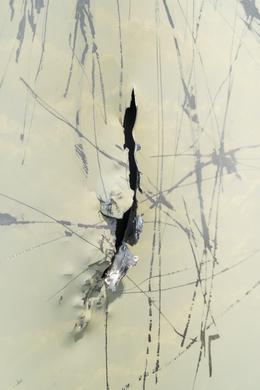
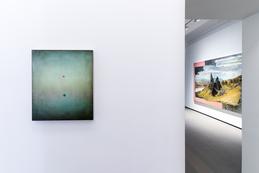
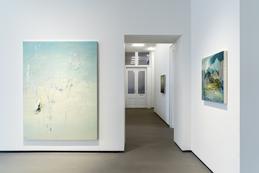
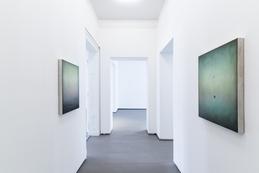
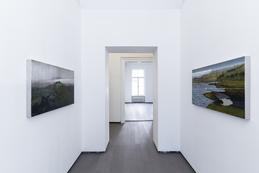
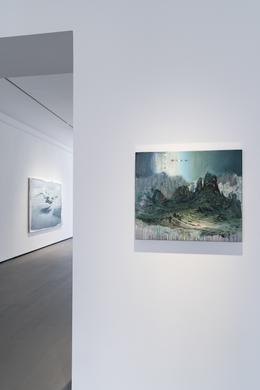
Clemens Tremmel, born in Eisenhüttenstadt in 1988, is considered the main representative of a “New German Romanticism”. However, the artist, awarded the Caspar David Friedrich Prize in 2013, seeks to gesturally disrupt the (Old) Masterly appearance of his paintings: sharp and heavy tools are his aids when unerringly adding traces of destruction.
Tremmel feels himself as a painter. Initially, in terms of style, his paintings appear historical – a precise as well as large-scale manner of painting, complete with its symbolism as a place of longing and perfection. With oil paint applied to picture supports such as aluminum sheets or textiles he enacts the transition to concept art and sculpture. Sometimes it is installations that give voice to these excursions to the creative margins of his work. Above all, the artist draws his inspirational power from his constant travels around the world and the associated boundary experiences.
It is above all the power of nature which, later, in the studio, he translates into the painterly. Here one can subsequently say, they look familiar to us. Why? With his landscapes he draws on the pictorial tradition of photography, which received its first images in 1826 through the Frenchmen Joseph Nicéphore Niépce and Louis Daguerre. His pictures look like snapshots, however this is also constructed. A picture center is consciously lacking. Everything is arranged symmetrically. So it does draw on the Old Masters? Here the absence of a central perspective is transferred from art history to our relationship to the world.
The similarity with subjects from Caspar David Friedrich (born September 5, 1774 in Greifswald, † May 7, 1840 in Dresden), is striking. (Even if one doesn’t know that Clemens Tremmel was awarded the prestigious Caspar David Friedrich Prize in 2013). After all, it was a longing for the healing of the world, directed to the infinite, and the unification of opposites to form a harmonious whole, that became the driving force in German Romanticism. And Tremmel appears to have mastered the complex romantic world order as a form of universal poesy. Thus the following ingredients also belong to his repertoire: emptiness, mysticism and mist as suggestive elements of Tremmelian art. Nevertheless, his approach is different! As a contemporary he breaks with naturalistic traditions. From a distance the human eye compensates for Tremmel’s abstractly painted pictures sections, and his landscapes are only intimated in places through the punctiform emission of light, and in others composed of sonorously luminous colors as an expression of radiant energy.
Old Masterly and gesturally abstract, he attempts to break the smooth impression of a lofty panorama. Axe, saw, chisel and stylus are the instruments he employs. The brush is at rest when Clemens Tremmel works over his paintings, leaving succinct traces of destruction on his motifs painted in oil. With empty spaces, sawn out of the picture support, compositional scratching, as well as overwriting and overpainting and the obscuring of picture sections, the painter points, pictorially, to deficits. His works seem to embody the effort required in pursuing the destruction of the integrated whole. Why actually? Through his approach he juxtaposes old and new worlds, and in the process it appears that he allows the Old Masters to speak, just as newer masters are given their say. At the same time Tremmel doesn’t just address the tension between creation and destruction, the process of passing away and renewed evolution in his works also appears to be halted at this moment; as if stasis is to be followed by a complete break or bursting. A moment that also continues to resonate in the viewer, and doesn’t just lend Tremmel’s physical works their monumentality.
“I cross a boundary in that I take what I believe in, and in the next moment demolish it again. I operate in opposition to my idealism - I betray it, question it. It is as if one were to cut one’s own flesh, and then watch how the wound grows together again. At any rate, one subsequently knows what one has experienced – and I find that exciting”, is how he describes this approach.
And his motifs? “I find myself in places where I anticipate being fascinated or overwhelmed – in front of which I simply get in a turmoil. Certain subjects that perhaps also allow me to integrate elements of the national culture into the composition.” Throughout, the focus is on the deep impressions that natural forces leave behind. “On Iceland, for example, I had the feeling: Everything is about to erupt. One senses, as it were, that one is standing on a volcano that is just lying dormant. I want to pass on this power which grows in me from out of such feelings. In contrast, most recently in Jordan, the impressions were much more playful, due to the omnipresent ornamentation. I felt like I was in a fairy tale from A Thousand and One Nights. And when painting figures suddenly emerged that looked like a mosaic. Thus a picture within a picture developed from different patterns — and from out of this grew, once again, the will to break it all. So I set out to break my pattern again.”
What is it exactly all about for Clemens Tremmel? “In any event it is never about simply creating an image of something, instead it is always about reproducing a feeling than a certain place triggers – capturing the moment. So that when you stand in front of the picture you can immerse yourself in this moment. This can procced by a naturalistic or an abstract route. The difference is made by the means that I develop.
I have always asked myself: How can I make my longing even clearer? How can I make the viewer even more conscious of my theme? So I began, retrospectively, to paint over parts of my pictures, or delete them. After I have created the ideal for myself – that which I had to depict, that which I personally believe in – I negate it again on the basis of a self-created action script. Which naturally causes me pain. Nevertheless: Destroying what I have worked on for a month within the space of five minutes has become an essential aspect of my work.”
– Sebastian C. Strenger (quotes from Clemens Tremmel)
Tremmel feels himself as a painter. Initially, in terms of style, his paintings appear historical – a precise as well as large-scale manner of painting, complete with its symbolism as a place of longing and perfection. With oil paint applied to picture supports such as aluminum sheets or textiles he enacts the transition to concept art and sculpture. Sometimes it is installations that give voice to these excursions to the creative margins of his work. Above all, the artist draws his inspirational power from his constant travels around the world and the associated boundary experiences.
It is above all the power of nature which, later, in the studio, he translates into the painterly. Here one can subsequently say, they look familiar to us. Why? With his landscapes he draws on the pictorial tradition of photography, which received its first images in 1826 through the Frenchmen Joseph Nicéphore Niépce and Louis Daguerre. His pictures look like snapshots, however this is also constructed. A picture center is consciously lacking. Everything is arranged symmetrically. So it does draw on the Old Masters? Here the absence of a central perspective is transferred from art history to our relationship to the world.
The similarity with subjects from Caspar David Friedrich (born September 5, 1774 in Greifswald, † May 7, 1840 in Dresden), is striking. (Even if one doesn’t know that Clemens Tremmel was awarded the prestigious Caspar David Friedrich Prize in 2013). After all, it was a longing for the healing of the world, directed to the infinite, and the unification of opposites to form a harmonious whole, that became the driving force in German Romanticism. And Tremmel appears to have mastered the complex romantic world order as a form of universal poesy. Thus the following ingredients also belong to his repertoire: emptiness, mysticism and mist as suggestive elements of Tremmelian art. Nevertheless, his approach is different! As a contemporary he breaks with naturalistic traditions. From a distance the human eye compensates for Tremmel’s abstractly painted pictures sections, and his landscapes are only intimated in places through the punctiform emission of light, and in others composed of sonorously luminous colors as an expression of radiant energy.
Old Masterly and gesturally abstract, he attempts to break the smooth impression of a lofty panorama. Axe, saw, chisel and stylus are the instruments he employs. The brush is at rest when Clemens Tremmel works over his paintings, leaving succinct traces of destruction on his motifs painted in oil. With empty spaces, sawn out of the picture support, compositional scratching, as well as overwriting and overpainting and the obscuring of picture sections, the painter points, pictorially, to deficits. His works seem to embody the effort required in pursuing the destruction of the integrated whole. Why actually? Through his approach he juxtaposes old and new worlds, and in the process it appears that he allows the Old Masters to speak, just as newer masters are given their say. At the same time Tremmel doesn’t just address the tension between creation and destruction, the process of passing away and renewed evolution in his works also appears to be halted at this moment; as if stasis is to be followed by a complete break or bursting. A moment that also continues to resonate in the viewer, and doesn’t just lend Tremmel’s physical works their monumentality.
“I cross a boundary in that I take what I believe in, and in the next moment demolish it again. I operate in opposition to my idealism - I betray it, question it. It is as if one were to cut one’s own flesh, and then watch how the wound grows together again. At any rate, one subsequently knows what one has experienced – and I find that exciting”, is how he describes this approach.
And his motifs? “I find myself in places where I anticipate being fascinated or overwhelmed – in front of which I simply get in a turmoil. Certain subjects that perhaps also allow me to integrate elements of the national culture into the composition.” Throughout, the focus is on the deep impressions that natural forces leave behind. “On Iceland, for example, I had the feeling: Everything is about to erupt. One senses, as it were, that one is standing on a volcano that is just lying dormant. I want to pass on this power which grows in me from out of such feelings. In contrast, most recently in Jordan, the impressions were much more playful, due to the omnipresent ornamentation. I felt like I was in a fairy tale from A Thousand and One Nights. And when painting figures suddenly emerged that looked like a mosaic. Thus a picture within a picture developed from different patterns — and from out of this grew, once again, the will to break it all. So I set out to break my pattern again.”
What is it exactly all about for Clemens Tremmel? “In any event it is never about simply creating an image of something, instead it is always about reproducing a feeling than a certain place triggers – capturing the moment. So that when you stand in front of the picture you can immerse yourself in this moment. This can procced by a naturalistic or an abstract route. The difference is made by the means that I develop.
I have always asked myself: How can I make my longing even clearer? How can I make the viewer even more conscious of my theme? So I began, retrospectively, to paint over parts of my pictures, or delete them. After I have created the ideal for myself – that which I had to depict, that which I personally believe in – I negate it again on the basis of a self-created action script. Which naturally causes me pain. Nevertheless: Destroying what I have worked on for a month within the space of five minutes has become an essential aspect of my work.”
– Sebastian C. Strenger (quotes from Clemens Tremmel)
Artists